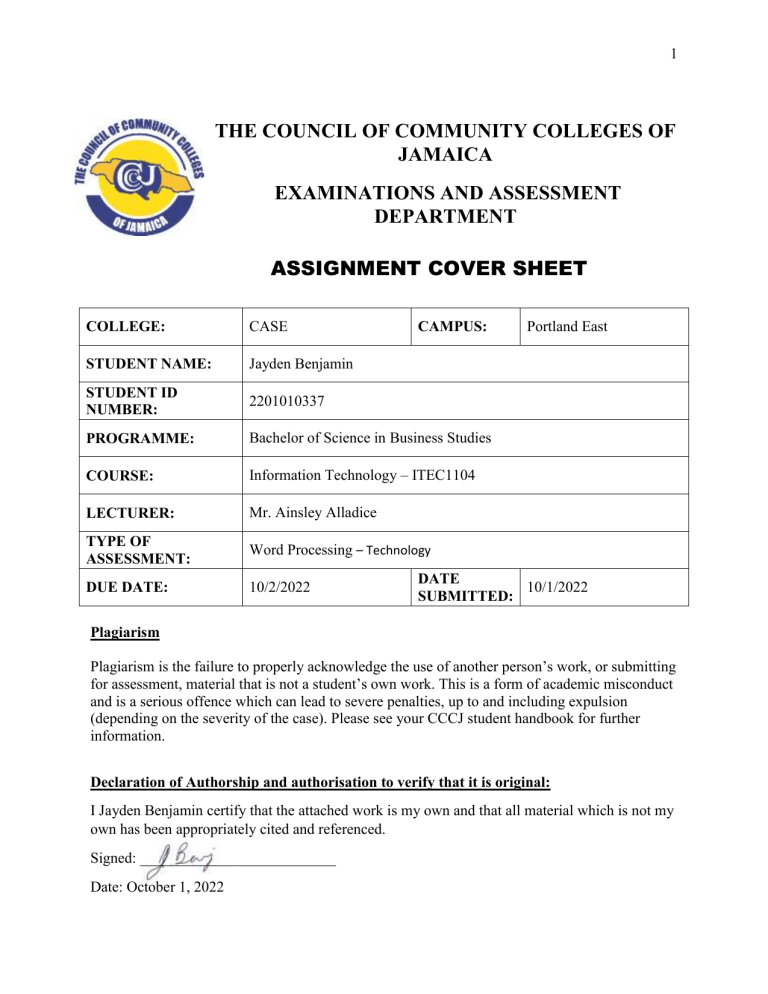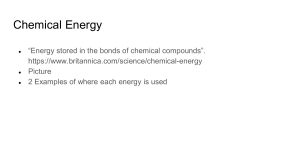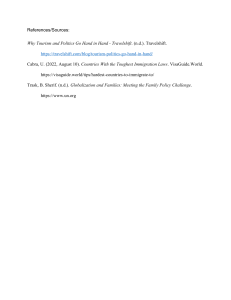IT Essay: Technology Evolution & Social Media in Education
advertisement

1 THE COUNCIL OF COMMUNITY COLLEGES OF JAMAICA EXAMINATIONS AND ASSESSMENT DEPARTMENT ASSIGNMENT COVER SHEET COLLEGE: CASE STUDENT NAME: Jayden Benjamin STUDENT ID NUMBER: 2201010337 PROGRAMME: Bachelor of Science in Business Studies COURSE: Information Technology – ITEC1104 LECTURER: Mr. Ainsley Alladice TYPE OF ASSESSMENT: Word Processing – Technology DUE DATE: 10/2/2022 CAMPUS: Portland East DATE 10/1/2022 SUBMITTED: Plagiarism Plagiarism is the failure to properly acknowledge the use of another person’s work, or submitting for assessment, material that is not a student’s own work. This is a form of academic misconduct and is a serious offence which can lead to severe penalties, up to and including expulsion (depending on the severity of the case). Please see your CCCJ student handbook for further information. Declaration of Authorship and authorisation to verify that it is original: I Jayden Benjamin certify that the attached work is my own and that all material which is not my own has been appropriately cited and referenced. Signed: __________________________ Date: October 1, 2022 2 Contents Introduction .................................................................................................................................................. 3 The Evolution of Technology......................................................................................................................... 4 What is Digital Technology? ........................................................................................................................ 5 Modern Technology ...................................................................................................................................... 6 Using social media for educational purposes ............................................................................................... 7 References .................................................................................................................................................... 8 3 Introduction There has been a longstanding folklore that states that “Necessity is the mother of all inventions,” and it is through this necessity that we have seen various advancements helping to enhance our quality of life as humans. This deep desire has helped to shape our interactions with each other, facilitate improvement in our well-being as well as grant us the ability to guide society to a more widely accepted ethical point that benefits the masses. This paper will explore the various complexities and developments in technology which has contributed to the age we live in and what it took to get there. 4 The Evolution of Technology Technology can be described as how we apply knowledge to build inventions or solve a problem. In the stone age tools were formed around the 3 basic needs: food, shelter, and clothing. Flaking saw its first use in the production of sharp stone edges by using a hammerstone (a rounded plain stone) to chip away at another stone to form a sharp edge. (Penfield, n.d.) The bronze age in development saw the use of copper in the making of small objects for further use and saw the use and increased specialization of the wheel (Britannica, n.d.) More lethal weapons were also made by combining copper with zinc to form a new alloy. During the iron age, we saw the boundless work of ferrous metallurgy and the early advancement of carbon preparation for devices and weaponry, iron’s development as the pre-famous designing material of the time was not introduced by any critical developments in materials handling (Smith, 2019). The medieval age saw the rise of many advances in technology, including gunpowder, the windmill, eyeglasses, and the printing press. This period also saw the rise of measurement devices such as the mechanical clock and the compass (Libguides, n.d.). The technological changes incorporated during the industrial age included the use of coal, electricity, and petrol as power sources, the internal-combustion engine, a new association of work known as the plant (factory) framework, and the invention of various vehicles including the plane, steam train and the automobile (Britannica, 2022). The electronic age, also regarded as the digital age is the period of transition from traditional industry to an economy based on information computerization. Some of the advancements of this era include the cathode ray tube which pioneered the television, computers, email, and GPS. This period has revolutionized the way information is sent and accessed (Kelechi, 2018). 5 What is Digital Technology? The Cambridge Dictionary defines digital as, “recording or storing information as a series of the numbers 1 and 0 to show that a signal is present or absent, (Cambridge, n.d.) while technology is regarded as applying knowledge in a specific area (Merriam-Webster, n.d.), therefore we could describe digital technology as utilizing binary data to solve a problem. A more substantial meaning would designate digital technology as electronic tools, systems, devices as well as resources that produce, store, or/and process data (IGI Global, n.d.). Data is recorded in combinations of the digits 0 and 1, also referred to as bits, allowing the ability for a wide range of calculations. Digital technology empowers enormous measures of data to be compacted to storage that can be protected and transported and allows for faster dissemination of data and information (Encyclopedia.com, n.d.). Innovations in fiber optics pioneered the transition from analog signals to the use of digital technology which saw the rise of cellular phones and other digital forms of communication. Analog converters that converted signals to digital were also utilized to help phase out distortion as well as to make the output signal easier to duplicate (Encyclopedia.com, n.d.). Some other examples of highly impactful digital technologies include websites, video streaming, digital music, social media, digital clocks, ATMs (Automated teller machines), and cryptocurrency (Goodman, 2022). By upgrading networks, monetary consideration, admittance to exchange, and public administrations, innovation can strike an incredible balance. In the wellbeing area, for example, artificial intelligence-empowered advances are assisting with saving lives and analyzing sicknesses while expanding life expectancy. In training, virtual learning conditions and distance learning have opened projects to those who study which might some way or another be prohibited (UN, n.d.). 6 Modern Technology Modern technology can be described as alterations made to older technology to bring about innovation, increasing efficiency, and convenience. Technology has become vital because it is utilized on a large scale in our everyday lives, and like most things, technology enjoys benefits and hindrances. To begin with, the development of technology is gainful to people in multiple factors. At the clinical level, technology can assist and treat the ill and save many lives while helping to combat deadly viruses and microbes. The innovation of the PC was a vital point. Correspondence is subsequently improved, and organizations can convey even more effectively to other nations. Research is subsequently streamlined. Trades are quicker on the web and shopping on a multinational level has become simplified. The next major benefactor of modern technology is travel and accommodations which have seen a sharp increase with the implementation of booking and lodging services. Then again, the development of present-day innovation has impediments, for instance, reliance on technology. The downfall of human resources suggests an expansion in joblessness. In certain areas, gadgets can replace the human psyche (Ismail, 2017). There is likewise little uncertainty that the new advancements in general, driven, are moulding the way we think in ways self-evident and unpretentious. A developing collection of exploration suggests that innovation can be both useful and destructive to various manners in which youngsters think. In addition, this impact isn’t simply influencing youngsters on the outer layer of their reasoning. Rather, because their cerebrums are still growing, prolonged submission by children of the modern age to technological content is affecting the mind in manners altogether different than in past ages (Taylor, 2012). 7 Using social media for educational purposes As of late, social media outlets have developed past networking to turn into a strong educational instrument. There exists a deficiency in the utilization of social media in the distribution of knowledge on a professional level for training, especially among understudies from different demographics. Bridging this gap would be imperative in distributing and accessing quality academics across the globe in different sectors, but this, like many developments, won’t have the desired impact without a few challenges in implementing, utilizing, and sustaining this process (YSU, 2021). One may ask if streamlining the education process through social network channels is worth the hassle. During the 2020 COVID19 pandemic, we saw where different educational institutions had to adapt to various streaming, videoconferencing, and online social spaces to conduct classes in observance of social distancing guidelines, to an extent which some have resorted to keeping this practice to facilitate distant learning as well as added flexibility for educators and students alike who can’t fit in the face-to-face routine. If we were to adapt different aspects of social media sites like Facebook as an integral part of educational matriculation then we would then have a central means to incorporate streaming, videoconferencing, subject-based social spaces as well a host of other digital services, helping to limit the drop off from information dissemination by adding various channels to access the content at any given time. This hybrid model can be seen being utilized by many early adaptors, supplementing a thorough and rigorous learning experience inclusive of the ability to adapt to future trends in the social media learning space. Meta-verse for example could be incorporated into social network-based school groups in the adaptation of interactive virtual learning. 8 References The Evolution of Technology Penfield. (n.d.). The Old Stone Age. https://www.penfield.edu/webpages/jgiotto/onlinetextbook.cfm?subpage=1525824 Britannica. (2022, Sep 20). The Bronze Age. https://www.britannica.com/event/Bronze-Age Smith, N. (2019, September 9). “The seven ages of materials”: The Iron Age. Theiet. https://eandt.theiet.org/content/articles/2019/09/the-seven-ages-ofmaterials/#:~:text=The%20end%20of%20the%20Iron,and%20then%20the%20Middle% 20Ages. Libguides. (n.d.). “Medieval World”: Inventions in the Middle Ages. https://mfgsc-vic.libguides.com/c.php?g=916765&p=6610145 Britannica. (2022, August 23). Industrial Revolution. https://www.britannica.com/event/Industrial-Revolution Kelechi, A. (2018, December 17). “The Electronic Age”: The industrial Age and the Electronic Age 1. Kmacims. https://www.kmacims.com.ng/industrial-age-and-electronicage/#The_Electronic_Age What is Digital Technology? Cambridge Dictionary. (n.d.). Digital Definition. https://dictionary.cambridge.org/dictionary/english/digital Merriam-Webster Dictionary. (n.d.). Technology Definition. https://www.merriam-webster.com/dictionary/technology 9 IGI Global. (n.d.). Digital Technology. https://www.igi-global.com/dictionary/digital-technology/7723 Encyclopedia.com. (n.d.). Digital Technology. https://www.encyclopedia.com/history/dictionaries-thesauruses-pictures-and-pressreleases/digital-technology Goodman, P. (2022, January 7). “Examples of Digital Technology”: 20 Examples of Digital Technology. Turbo Future. https://turbofuture.com/misc/Examples-of-Digital-Technology United Nations. (n.d.). The Impact of Digital Technologies. https://www.un.org/en/un75/impact-digital-technologies Modern Technology Swalih, M. (2021, December 20). “Modern Technology”: Definition, Examples and Applications. Techquintal. https://www.techquintal.com/modern-technology/ Ismail, N. (2017, April 10). “Modern Technology”: Advantages and Disadvantages. Information-age. https://www.information-age.com/modern-technology-advantagesdisadvantages-123465637/ Taylor, J. (2012, December 4). How Technology is Changing the way Children Think and Focus. Psychology Today. https://www.psychologytoday.com/intl/blog/the-powerprime/201212/how-technology-is-changing-the-way-children-think-and-focus Using social media for educational purposes Youngstown State University. (2021, September 13). How to use social media in education. https://online.ysu.edu/degrees/education/msed/curriculum-instruction-digitalteaching/use-social-media-in-education/






